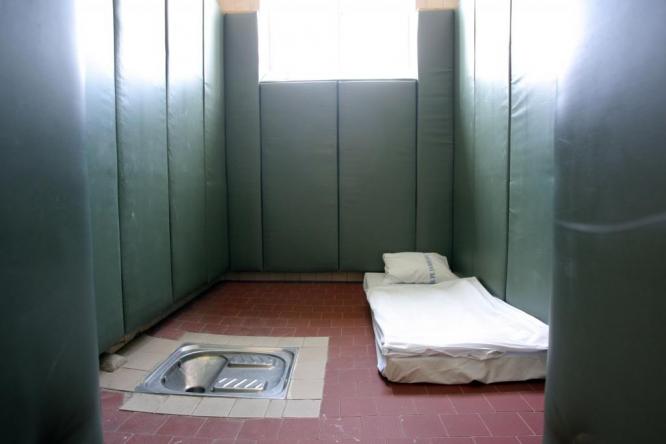7(C). Seclusion
Most hospitals which MDAC visited had seclusion rooms, the exceptions being at Klatovy Hospital Psychiatric Department and at Lnáře Psychiatric Hospital. The director at Plzeň Hospital Psychiatric Department said that there were no seclusion rooms, although rooms with cage beds were sometimes used for seclusion. Klatovy, Opařany, Dobřany and Kosmonosy hospitals all had seclusion rooms, most with physical restraints at the ready.
At Dobřany Psychiatric Hospital the seclusion room was located at the end of the hallway. It contained a mattress and a “Turkish toilet” (a hole in the ground above which the person must crouch). The window could be opened from outside the room and the heating controls were also external. The seclusion room was, according to the staff “very hot”, because “some of the patients in seclusion are naked, because they could harm themselves with their clothes.”
Unit 13 of Dobřany Psychiatric Hospital had five seclusion rooms. Two contained a bed and were padded. Three were without a bed and had a slanted floor. Seclusion rooms such as these were described in a report by the European Committee for the Prevention of Torture in their 2006 report after visiting the institution: “[T]he floors of these tiled cells were uneven, with an incline down towards the floor level toilet; several patients complained that their mattresses would slide towards the toilet during the night”.81 At Prague Bohnice Psychiatric Hospital seclusion rooms are frequently used. According to staff, some patients are medicated too and most are strapped.
An isolation room for girls
On the girls’ ward at Opařany Children’s Psychiatric Hospital, the seclusion room had blinds that could be opened. At the time of the monitoring team’s visit, the straps had been sent to wash (indicating their recent use) and there were two more primitive sets in storage. There was a light switch inside the room, and an electrical box on the wall which presented an additional risk, although it was high enough on the wall to be out of reach.
The window could be opened fully, which also seemed to be a risk. The seclusion room could not safely be used for secluding an agitated child without the additional use of physical restraints, otherwise the person may jump out of the window. On this basis, the monitoring team concluded that the seclusion room was most likely only used in combination with physical restraints.
There was some minor material damage to the walls, repaired and painted over. There was a smoke detector. The staff said that there were no legal provisions regulating the interior of seclusion rooms or the equipment which one should contain. It appeared that the room was used often, and sometimes children asked the staff to go there because they wanted to be left alone. The director of the institution told the monitoring team that, “if a child is in fear then seclusion rooms are good”.
MDAC monitors were told that the two seclusion rooms for girls age 13 to 18 had been used eight times in February 2013. The last child had been placed in straps for 40 minutes, according to the director. A nurse wanted to respond to a monitor’s question about how often a child in the seclusion room was checked, but the director jumped in and said monitoring was “continuous, or every five minutes, or according to the internal rules”, then “according to the level of agitation” and finally clarified that the minimum interval for checking was 30 minutes. After repeated questioning she said that, “a nurse monitors all the time, every 5 minutes, but it is a demanding job”. The monitoring team were left wondering which of the variety of answers most closely resembled the reality.
Staff at Prague Bohnice Psychiatric Hospital told MDAC monitors that a doctor always reviewed the necessity of seclusion before the event, and every 12 hours once the placement in seclusion had begun. The longest stay in seclusion reported by staff was almost two months. The seclusion room had one bed and a window with unbreakable glass, and a toilet was located outside the room. At Dobřany Psychiatric Hospital, staff told MDAC monitors that patients could be placed in seclusion for a maximum of three days, and were checked every three hours. Overall, there seemed to be wide variety of practice across the country, with no national policy or discussion as to minimum standards. The result is inevitably that many people are placed needlessly in seclusion, for too long, without regular enough review, and placing them at substantial risk.
81 European Committee for the Prevention of Torture, Report to the Czech Government on the visit to the Czech Republic carried out by the European Committee for the Prevention of Torture and Inhuman or Degrading Treatment or Punishment (CPT) from 27 March to 7 April 2006 and from 21 to 24 June 2006, supra note 35, at para. 115.


